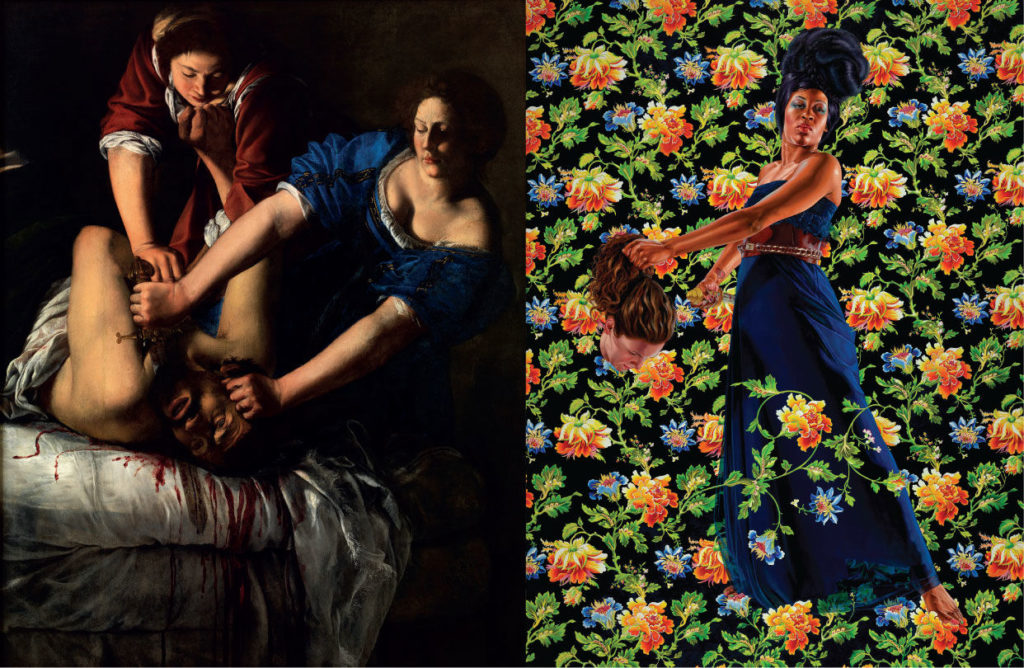Kehinde Wiley is a classically trained African American painter who attempts to remake the western canon of art. Since the history of European art predominantly features people with fair skin, Wiley attempts to rectify this perceived injustice by copying the Old Masters and replacing light-skinned people with dark-skinned people. In a way, Wiley is to Art History what Lin-Manuel Miranda is to American History.
The Museum of Fine Arts Houston recently announced they will be exhibiting Wiley’s 21st c. “Judith and Holofernes” alongside Gentileschi’s work of the same theme from the 17th century. (See photo above)
The historical nature of the book of Judith is highly questioned and most assign it the genre of historical romance in the time of the Maccabees. This isn’t necessarily an instance of historical revision. Whatever the degree of historical accuracy the book of Judith may have, the book has been described as “true to the spirit of the time” (See E.L. Hicks’ “Judith and Holofernes, Journal of Hellenic Studies, 1885). The story is about one courageous Jewish woman’s triumph over a pagan Assyrian general in a time of increasing anger against foreign oppression. I suggest Wiley’s painting is also true to the spirit of our time, though not in the way he intends. Rather than “empowering” African Americans and “speaking the language of equity”, Wiley’s work plods along with progressive critical theories, toying with gender reversal and racial violence.
The slain woman is face down; we cannot make eye contact. There is no sympathy for her as an individual; she represents all white women. Each woman has been given, in Wiley’s view, her rightful place. His typical background of botanical wall-paper eliminates context and individuality. Each woman represents her “race” because critical theory insists individuals are inseparable from their group identities. The title of the piece is a distraction; we’re not looking at Judith and Holofernes but at what the MFAH describes as “a powerful Black woman wearing a designer gown and looking directly at the viewer while holding the severed head of a White woman.” Given the racial tensions of our time, it’s difficult not to see overt racial hatred in this piece (There is blood on the sword, after all) and it would be unquestionable if the roles were reversed.
I suggest the painting also works another way. It accurately portrays how museum elites participate in the degradation of the arts under the guise of “exploring race and power” and the art world has truly lost its head by adopting all progressive claims about the past and its relationship to the present.
What is the biblical response to Wiley’s work? Consider three areas of analysis:
1. Technical Excellence- We can affirm Wiley’s mastery of technique, especially of the human form.
2. Validity- Wiley’s work corresponds with his stated goals, which is to create representation for dark-skinned people in the history of art. He is honest to himself and truly believes gender/race reversals are valuable in and of themselves:
“What I’m doing is playing with the language of power that has existed in Western easel painting for hundreds of years, and I’m trying to use certain aspects of that to my own purposes.” -KW (ncartmuseum.org, “Judith and Holofernes.”)
3. Worldview-We cannot affirm Wiley’s worldview because he promotes unbiblical social justice rather than biblical justice. Biblical justice takes God’s law as its standard, not the external standards of progressive political and social theories. The Bible explains, “Evil men do not understand justice, but those who seek the Lord understand all things.” (Prov. 28:5)
Without context, “Judith” deals out vengeance, whereas the Bible assigns the role of the avenger to God: “Vengeance is mine; I will repay (Deut. 32:35). The Bible opposes the idea of “giving people what they deserve”; Do not repay anyone evil for evil” (Romans 12:17).
Additionally, we cannot affirm reverse racism, no matter how subtle or disguised, because all racism is sin. All people are descended from our original parents, created in the image of God, with inherent worth and dignity (Gen. 1:27) Galatians 5:14 says, “For the whole law is fulfilled in one word: “You shall love your neighbor as yourself.” I suggest love is utterly absent from Wiley’s work.
If you visit the MFAH (Houston, TX) and view this exhibit, I encourage you to ask for a comment card at the Guest Service desk and give the curatorial staff feedback on Wiley’s piece.

Your educational career is quite impressive, especially your interest in art and apologetics. And you are a wife and Mom. Blessings!
Thanks so much for stopping by, and thanks for the kind words. Have a blessed day! ~Scarlett